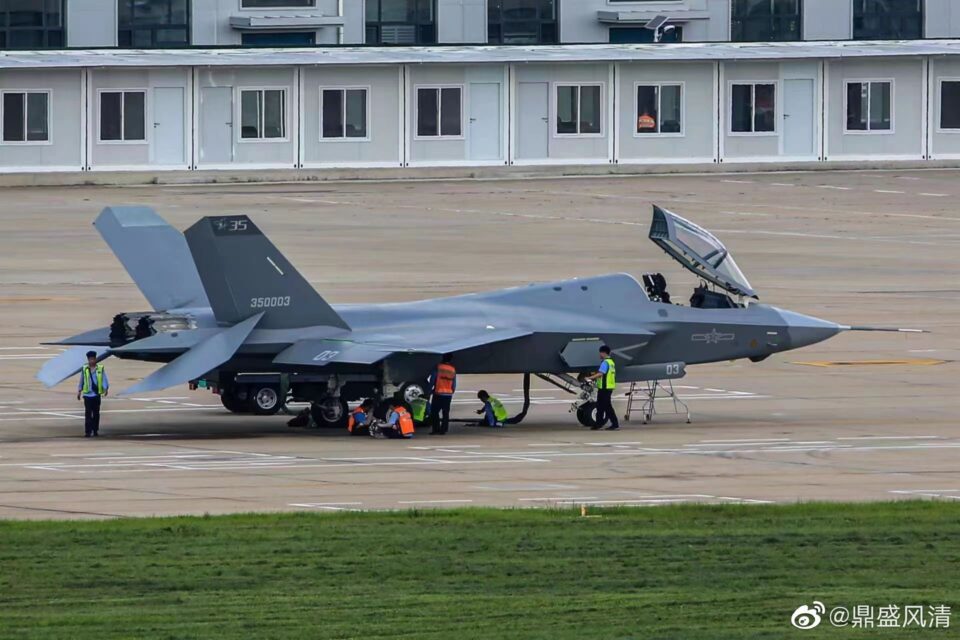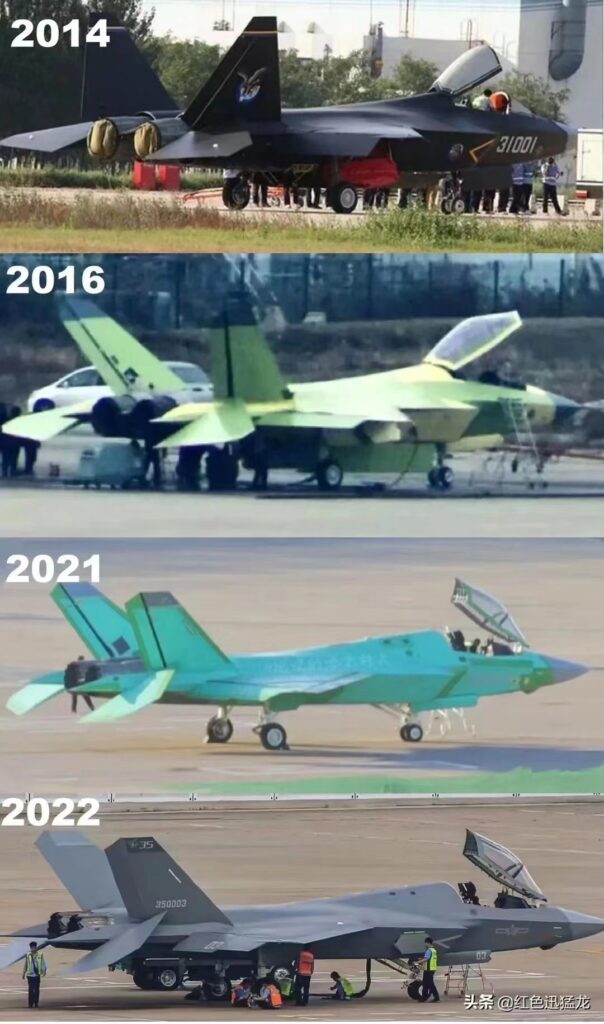Aviation
China displays the most recent J-35 stealth fighter with a new jet engine. WS-21
For the first time, a high-resolution image of a Chinese Shenyag J 35 surfaced, as evidence of China’s competitive edge over western aircraft in the production of commercial and military aircraft.

For the first time, a high-resolution image of a Chinese Shenyag J 35 surfaced, as evidence of China’s competitive edge over western aircraft in the production of commercial and military aircraft.
China may enter a new aircraft in the Fifth Generation Fighter race. The US has created two fighter jets, the F22 and F35, while on the other side, Russia has built one fifth-generation fighter jet, the Sukhoi Su-57, and will soon begin production on a second Su 75 that will be used for combat. A fifth-generation Checkmate prototype that will also be unveiled soon. Even Turkey is developing its own fifth-generation fighter aircraft, the TAI TF-X. India is also working on creating its own fifth-generation fighter plane, the AMCA.
The project was previously referred to as J 31 and later changed to J 35 in 2019. The project was initiated in 2011, and lately, after extensive development, the first pictures of the completed J-35 aircraft were released.
Shenyang Aircraft Corporation created the mid-sized twinjet J-35, a prototype fighter jet of the fifth generation (SAC). Even though sources have hinted that China is preparing a sophisticated plane before, this is the first time such clear images of the jet have appeared online. The prototype, also referred to as the FC-31, is a direct rival to Lockheed Martin’s F-35 II Lighting, which is recognised as the best fighter jet in the world and comes in three variants: A, B, and C based on operational capabilities. It resembles the naval version of the Chinese Shenyang J-35.
The J-35 appears to be a navy variant fighter jet; it has the serial number 35003 on its side and is painted in a grey tactical paint job with a muted national emblem. Other marks, like as those on the canopy and engines, are also apparent in the pictures.
We can now see the integral bulkhead at the back of the F-35-like front-opening, internally bent canopy. The rear canopy arrangement of the A and C models of Lockheed Martin’s F-35 Joint Strike Fighter is largely comparable to this.
China might want to sell the planes overseas as an option for nations unable to purchase the F-35
The improved FC-31 naval variant, known as the J-35 by observers, flew for the first time on October 29, 2021. It will be operated using an electromagnetic Aircraft Launch System from the upcoming Type 003 aircraft carrier.
J-35 number 350003 … a few details! pic.twitter.com/Yp3JqIWvu4
— @Rupprecht_A (@RupprechtDeino) July 22, 2022
The principal armaments of the J-31 are the PL-10 short-range missile and PL-12 medium-range air-to-air missile, and it is capable of carrying 8,000 kg (18,000 lb) of payload, with 6,000 kg (13,000 lb) carried on six external hardpoints and four munitions weighing 2,000 kg (4,400 lb) each inside. It is also possible to mount 4 PL-21 missiles within the J-31’s internal weapons compartment. It can lift a maximum of 25,000 kg (55,000 lb) and has a fighting radius of 648 nmi (746 mi; 1,200 km).
Its power system consists of two WS-13 afterburning turbofans with a combined thrust of 87.2 kN (19,600 lbf) and two WS-19 afterburning turbofans with a combined thrust of 110 kN (24,000 lbf) apiece.
The FC-31, a naval derivative, is expected to launch from and land on Type 004, China’s fourth scheduled aircraft carrier. China is testing the J-10D, an upgraded version of the J-10 that was developed in conjunction with the Pakistan Air Force, in addition to the FC-31.

Aviation
Airbus Enhances A350 Cabin with 10-Abreast Seating

Airbus has announced a new partnership with Jiatai Aircraft Equipment, a Chinese aircraft seating manufacturer, to supply upgraded economy-class seats for the A350 widebody series.
This collaboration, unveiled at the 2024 Airshow China, focuses on developing a newly designed economy seat tailored for the A350‘s New Production Standard (NPS) cabin.
One of the key features of the NPS cabin is the ability to accommodate 17-inch wide economy seats, compared to the previous 16.5-inch wide seats that airlines were limited to in the A350’s earlier configurations.
British Airways Unveils Its Brand-New First Class Cabin for the Airbus A380
This change is made possible by the expanded space in the NPS cabin, which is 35 inches longer and 4 inches wider than the previous version. This extra space is achieved by slightly moving the cockpit wall forward and shifting the rear pressure bulkhead back by one frame.
The wider cabin allows airlines to add up to 30 extra economy seats without compromising comfort. For airlines opting for a 3-4-3 seating layout, the 17-inch wide seats are an excellent choice for a more comfortable passenger experience. However, some airlines, such as Iberia, may choose to retain a 9-abreast layout with wider seats for added comfort.
The NPS cabin also offers enhanced flexibility for airline operators. One major advantage is the ability to easily switch between a 9-abreast and 10-abreast seating configuration without requiring significant downtime for aircraft reconfiguration. Airlines can use the same seat rails, tracks, and IFE interfaces, making the transition smoother and quicker.
Etihad Airways Unveils 10 Exciting New Routes for 2025
In addition, the design of the floor attachments and air-conditioning systems has been optimized for 10-abreast seating, meaning airlines can upgrade their cabins without needing to make substantial modifications to the aircraft’s structure.
Though it’s still unclear when Jiatai’s economy-class seats will be officially added to the A350’s Buyer Furnished Equipment (BFE) catalogue, the collaboration marks a significant step toward enhancing the A350’s cabin offerings.
With this partnership, Airbus is providing more seating options for airlines, ensuring that they can meet diverse customer needs while improving overall operational efficiency.
-

 Aviation2 months ago
Aviation2 months agoMicrosoft Flight Simulator Raises $3 Million to Bring Back the An-225 Mriya
-

 Airlines2 months ago
Airlines2 months agoQatar Citizens Can Travel to the United States Without a Visa
-

 Aviation2 months ago
Aviation2 months agoQatar Airways bans these new Electronic Devices on plane
-

 Airlines2 months ago
Airlines2 months agoJapan Airlines Rolls Out Free Domestic Flights to International Passengers
-

 Defence2 months ago
Defence2 months agoWhich Country Has the Largest Fleet of Fighter Aircraft?
-

 Airport2 months ago
Airport2 months agoWestern Sydney Airport Welcomes Its First Plane After 6 Years of construction
-

 Airlines4 days ago
Airlines4 days agoDAMAC Air: Dubai’s New Luxury Airline Offers Free Flights for Registration
-

 Aviation2 months ago
Aviation2 months agoDid you know ? Once Boeing 747 carried 1088 passenger in 1991









